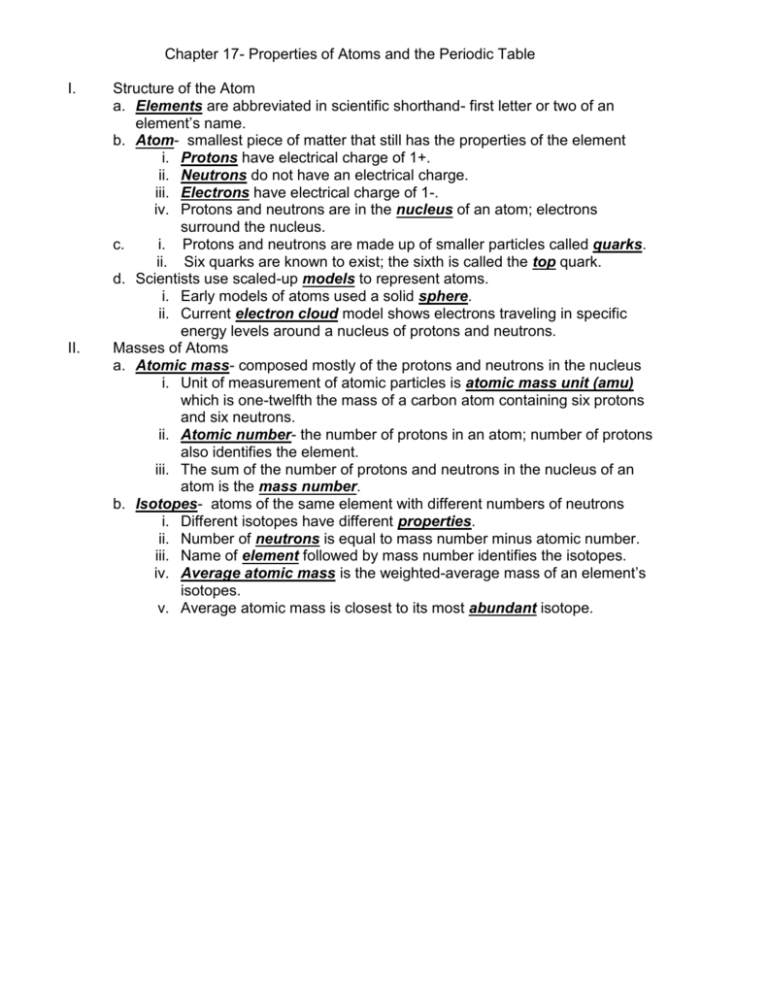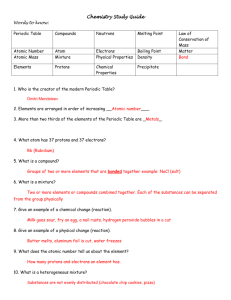Chapter 22- Properties of Atoms and the Periodic
advertisement

Chapter 17- Properties of Atoms and the Periodic Table I. II. Structure of the Atom a. Elements are abbreviated in scientific shorthand- first letter or two of an element’s name. b. Atom- smallest piece of matter that still has the properties of the element i. Protons have electrical charge of 1+. ii. Neutrons do not have an electrical charge. iii. Electrons have electrical charge of 1-. iv. Protons and neutrons are in the nucleus of an atom; electrons surround the nucleus. c. i. Protons and neutrons are made up of smaller particles called quarks. ii. Six quarks are known to exist; the sixth is called the top quark. d. Scientists use scaled-up models to represent atoms. i. Early models of atoms used a solid sphere. ii. Current electron cloud model shows electrons traveling in specific energy levels around a nucleus of protons and neutrons. Masses of Atoms a. Atomic mass- composed mostly of the protons and neutrons in the nucleus i. Unit of measurement of atomic particles is atomic mass unit (amu) which is one-twelfth the mass of a carbon atom containing six protons and six neutrons. ii. Atomic number- the number of protons in an atom; number of protons also identifies the element. iii. The sum of the number of protons and neutrons in the nucleus of an atom is the mass number. b. Isotopes- atoms of the same element with different numbers of neutrons i. Different isotopes have different properties. ii. Number of neutrons is equal to mass number minus atomic number. iii. Name of element followed by mass number identifies the isotopes. iv. Average atomic mass is the weighted-average mass of an element’s isotopes. v. Average atomic mass is closest to its most abundant isotope. III. The Periodic Table a. Elements are organized in the periodic table by increasing atomic number. i. In the late 1800’s, Dmitri Mendeleev devised the first periodic table based on atomic mass. ii. In 1913, Henry G. J. Moseley arranged the elements by atomic number rather than atomic mass. b. Vertical columns in the periodic table are groups of elements with similar properties. i. Elements in the same group have the same number of electrons in their outer energy level. ii. Each of the seven energy levels can have a maximum number of electrons. 1. Energy level one can contain at most two electrons. 2. Energy level two can contain at most eight electrons. iii. Each row in the periodic table ends when an outer energy level is filled. iv. Electron dot diagrams use the elements symbol and dots to represent outer energy level electrons. c. Periods- horizontal row of elements that contain increasing numbers of protons and electrons. i. Elements are classified as metals, nonmetals, or metalloids (semimetals). ii. Elements are synthesized in laboratories all over the world. d. The hydrogen elements exist all over the universe. i. Hydrogen and helium are the building blocks of other naturally occurring elements. ii. Supernovas spread heavier elements throughout the universe.











